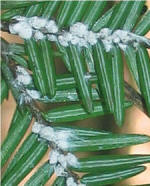The hemlock woolly adelgid, an
insect that nests in hemlock trees and feeds on hemlock sap, has become a serious
pest in lower Fairfield county. This pest is responsible for virtually all
of the dead Hemlock trees you see. While they have been in the area for
several years, we expect that this insect will be especially active this year
because of the warm winter. In previous years, Fairfield County had some
week-long cold snaps which killed the eggs. This has been an unusually
warm winter, and many more eggs have survived to hatch.

Hemlock Woolly Adelgid egg masses
Some of the first signs of this insect are white balls on the hemlock tree's
branches nearthe needles. These look like tiny cotton balls or wool
balls, or like the end of a Q-tip.
If the infestation is allowed to proceed, the hemlock tree will have some
branches that turn brown and then die. If this infestation is not
stopped, the entire tree will die. What's worse, the insects will move
to the surrounding trees and infest them.
The Hemlock Woolly Adelgid is an invasive species and was accidentally
imported from Asia.
Hemlocks are especially valuable trees because they flourish on steep hills and
thin soil in shady places where other evergreens won't grow. Connecticut has
already lost its elms and American chestnut trees, and we'd hate to see another
species die off.
Cotta Tree Experts recommends that you
call us now to diagnose and treat this dangerous insect.
For more information, please see the
USDA Pest
Alert for the Hemlock Wooly Adelgid
